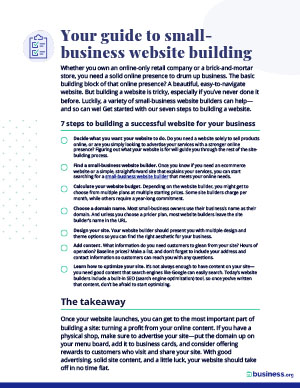We are committed to sharing unbiased reviews. Some of the links on our site are from our partners who compensate us. Read our editorial guidelines and advertising disclosure.
Ultimate Guide to Dropshipping
If you want to start an online business, one of the easiest and low-cost business models is dropshipping. This is a unique ecommerce business model that lets you sell products online but without the conventional overhead costs. As a dropshipping business owner, you can sell products directly to customers while your suppliers handle the inventory storage and product fulfillment.
Dropshipping lets you focus on building relationships with your customers, managing the sales and marketing, and delivering a great customer experience with your online business. Meanwhile, the back-end functions of inventory management and shipping are managed by your suppliers. While your business partners manage those costs and complexities, you can focus on being the best ecommerce seller you can be.
Let’s take a closer look at what dropshipping is, how it works, and everything you need to know to start a dropshipping business.
Table of contents
1. What is dropshipping?
Dropshipping is a type of online business that enables you to sell products and run your own ecommerce website, but without having to pay for inventory and warehouse space—or manage the details of fulfilling orders and shipping products. With dropshipping, you can sell products from your ecommerce website, and your suppliers handle the back-end operations of managing the inventory, packing the boxes, and shipping the purchases to your customers.
With a traditional retail business, you have to pay for a lot of overhead and operational costs:
- Retail storefront/retail space
- Inventory (the products on the shelves)
- Warehouse space
- Website
- Marketing
- Fulfillment, shipping and returns
With a dropshipping business, almost all of those costs go away. Dropshipping businesses don’t need to own a real-world storefront, keep inventory in stock, or own store shelves and warehouse space. And they don’t need to manage the fulfillment process or deal with customer returns. All of those usual costs of running a retail business get offloaded to your dropshipping suppliers who serve as your business partners.
As a dropshipper, you sell products to your customers at retail prices, and then buy the products from your suppliers at wholesale prices; the suppliers then ship the products to your customers. It’s like the typical retail business model of buying inventory at wholesale prices and then selling it at a profit, but slightly reversed: as a dropshipper, you don’t have to pay for your inventory until you’ve already made a sale. Much of the risk and cost of doing business as a traditional retailer is off of your plate.
As a dropshipping business owner, you can focus on what you do best as an ecommerce entrepreneur:
- Finding great products to sell
- Building relationships with customers
- Creating a brand for your business
- Making sales
- Earning profit
2. How does the dropshipping model work?
Does dropshipping sound too good to be true? What value do you add as a dropshipping “middle-man?” Let’s take a closer look at how the dropshipping business model works and why it can be a viable way for you to make money while connecting your customers with great products.
Wholesale vs. retail pricing
Anyone who has ever gone into a store knows what retail prices are; what consumers pay every day for products at stores, whether that’s groceries or phones or cars. But retailers are able to pay a lower price for the products they sell: wholesale.
Wholesalers are companies that buy products directly from manufacturers and then sell these products to retailers. Wholesale prices are much lower than retail prices because the manufacturers need to sell lots of products at once in bulk. Retailers are able to buy a large quantity of products with the expectation that they can sell these products at a higher price to make profit: the retail price.
Retailers cover the financial risk and the hassle of keeping products stocked and available so that consumers can find exactly the right products that they want to buy, at a price that they can afford. This might look like all of those loaves of bread on the grocery store shelves, or maintaining a warehouse full of T-shirts or laptops or televisions. Retailers help consumers sort through the complexity of the global economy and deliver products that meet people’s needs, without having to walk through miles of warehouse aisles.
As a dropshipper, you serve the same purpose as a typical brick-and-mortar retailer, but without the brick-and-mortar storefront. You provide people with access to products at retail prices, and you use your relationships with suppliers to get access to those products at wholesale prices.
Dropshipping example
Let’s say you run a dropshipping business that sells fitness equipment. You have a customer who wants to buy a set of dumbbells for home weight lifting. Your website offers this dumbbell set for $200 (retail price), and you have an agreement in place with a supplier who will provide this product to your business for a wholesale price of $150.
Here’s how the dropshipping process works:
- The customer buys a dumbbell set from your website for the retail price of $200 and provides their shipping information through your online order form.
- Your business places an order with your supplier for a dumbbell set and pays your supplier the wholesale price of $150.
- Your business gives your supplier the customer’s mailing address and other information necessary to complete the shipment.
- Your supplier packages and ships the dumbbell set to the customer.
- You make a $50 profit on the transaction ($200 retail - $150 wholesale = $50 profit).
Imagine repeating this process dozens or hundreds of times per month, and you can see how profitable dropshipping can be as a business model. And all without the overhead costs, risks, and hassles of running a conventional brick-and-mortar retail business.
3. Who are the key players (customer, supplier, retailer)
There are a few key players that make a dropshipping business work:
1. Customers: Without the customer, you don’t have a business. You’ll need to attract customers to your website and social channels, build up a relationship with customers based on trust, and create a strong brand for your business. With success, you can develop a reputation as a customer-friendly business that offers great products, an easy user experience, and excellent customer service. Always look for ways to build customer loyalty and encourage customers to make repeat purchases.
There are a few metrics to use to track the success of your dropshipping business:
- Conversion rate: This is the percentage of visitors to your website who actually buy from you. Along with having great products, your conversion rate will be improved by having a well-designed ecommerce website with an intuitive user experience (UX) that makes it easy to buy.
- Average order value: This is a measure of how much money people are spending at your business each time they order from you, on average. Boosting your average order value by cross-selling (offering additional products from different categories that might be of interest to the customer) and up-selling (offering higher-value products that the customer might want).
- New customer orders vs. repeat customer orders: When new entrepreneurs think about sales, they often think in terms of “finding new customers.” But the truth is, repeat customers can be even more valuable to your business. If you can build strong customer relationships, people will keep coming back to buy from you. Ideally, you should have a growing percentage of repeat customer orders. And as time goes by, you’ll build your dropshipping business’s reputation.
- Customer Lifetime Value (CLV): CLV is a measure of how much money a customer spends with you over the long-term “lifetime” of their relationship with your business. For example, if you have a customer who spends $100 per year at your business, and they keep buying from you every year for 10 years, the CLV for that customer is $1,000 ($100 per year x 10 years). Don’t just think about customers in terms of short-term acquisition or one-time transactions, but long-term relationships that can provide big value to your business for years to come.
2. Suppliers: Suppliers are central to your dropshipping business’s success, because they provide the actual products that you’re selling to your customers. Good, reliable suppliers will keep your business well-stocked with attractive, in-demand inventory that people are eager to buy. The best dropshipping suppliers are also good at fulfillment, with organized processes for picking, packing, and shipping your customers’ ecommerce orders.
Here are a few things to look for when you’re choosing dropshipping suppliers for your business:
- Inventory: Good suppliers will have an extensive inventory of products for your category, with a wide range of product types and price points. Providing access to the right products at the right price is job #1 for any wholesale supplier.
- Customer support: The best suppliers will typically offer a dedicated customer support rep who will help answer your questions and solve any problems. As a retailer, it’s a huge relief to be able to pick up the phone and call your suppliers in case there are issues or shipment delays. Find out more about your supplier’s customer support process before you buy from them.
- Technology: How easy is it to do business with your supplier? Can you send orders via email, by phone, via online order form, or all of the above? Is their website easy to use, or do they have a clunky interface? Is it easy to make payments via credit card? The quality of the supplier’s technology systems should make it easier for you to do business with them. Ask about features like real-time inventory, searchable order history, and customizable data feeds to help you simplify your business operations.
- Processes: How long does it take for orders to be fulfilled? Can they do same-day shipping? How long will it take for your customers’ orders to arrive at their homes? Be sure to account for possible time constraints when shipping products from international suppliers. The best suppliers have orderly, reliable processes to help avoid mistakes and keep your customers happy.
3. Retailers: As the dropshipping business owner, this is you! Congratulations: you are officially an ecommerce retail entrepreneur. Your customers will depend on you to find great products, give them a fair retail price, and deliver a high-quality customer experience. Here are a few aspects of running a retail business that you should keep in mind as you build your dropshipping company:
- Find great products: Dropshipping entrepreneurs often have small ecommerce websites that cannot offer the same range of products as big retailers. However, if you know your products well, and if you’re on top of the latest trends in your industry, you can offer great products that suit specialized needs and interests for your customers.
- Build a great website: It’s become easier than ever before to build an ecommerce website. You don’t have to be a technology expert, but you do need to think strategically about how you want your website to work, and what user experience (UX) you want to offer. Keep your website simple, intuitive, and easy to navigate. Make sure your website works well on mobile devices, as many consumers use mobile phones as their primary tool for accessing the Internet. Make it easy for people to find the “Buy” button so they can actually buy from you. Over time, you will want to add more features to your ecommerce website to help attract traffic and drive conversions.
- Measure your results: Depending on which platform you use to set up your ecommerce website, you can get access to easy analytics tools to show you how your business is performing. A few KPIs to help you measure the quality of your online retail customer experience include:
- Site traffic: How many visitors are coming to your site.
- Bounce rate: What percentage of visitors are leaving after only viewing one page.
- New visitors vs. returning visitors: More repeat customers is a good sign; this means you are building customer loyalty and higher Customer Lifetime Value .
- Time on site: How long are people staying on your website? The more time the better; this is a sign that you’re generating engagement and building relationships with customers .
- Click-through rates (CTR) and conversion rates: How many people are actually clicking “Buy” and checking out? How many people are clicking each link or asset on your website?
- Subscription rates: Are people signing up for your email newsletter or subscribing to your social media channels? This is a sign that people like your business and want to stay in touch to build a relationship with your brand.
- Shopping cart abandonment rate: How many people are going through the shopping process, adding items to their cart, but then abandoning your site without completing a purchase? If too many people are abandoning your cart, this could be a sign that your checkout process is too complicated.
As your dropshipping business grows, there are many other KPIs and metrics that you can use to measure your business’s performance, identify issues, and make improvements along the way. Whether it’s running a brick-and-mortar store or managing an ecommerce website, a retailer’s work is never done. And that’s OK! Because if you love what you do, and you enjoy the process of making sales and building relationships with customers, running a successful dropshipping business won’t feel like “work.”
4. How to find a profitable niche
As a dropshipping entrepreneur, you can’t expect to sell everything to everyone; you need to specialize and find a narrower niche in the market. You can’t compete with the biggest companies on price or selection, but you can compete based on your knowledge and passion for a specific niche. If there is a type of product, industry, hobby, or lifestyle that you are particularly passionate about, you might want to build your niche around that. If you have products that you know and love, an industry vertical that you care about, and suppliers that you believe in, your dropshipping business can be a passion project.
Or if you want to take a less emotional and more analytical approach, there are a few strategies you can use to look at data to help choose a niche for your business.
Use Google Keyword Planner: This is a search keyword tool that Google offers for free to help you understand the latest search trends: which keywords people are searching for, what is the search volume, how many people are looking, which keywords are more popular or less popular. Google Keyword Planner can help you identify which search words are most in-demand, which topics people are looking to research, and how competitive each search keyword is, in terms of how hard it is to get highly ranked in the search results.
Use this data to help decide which niches might be profitable for your business. For example, if you are thinking about launching a business that sells wellness products, you could check the keyword search volume for “wellness,” and then see Google’s list of related keyword ideas. This approach can give you ideas for other products or categories, like “wellness supplements,” “sleep aids,” and more.
Use Google Trends: Google Trends is another search data analysis tool that Google provides for free; you can use this to see data and get insights about search keyword performance over time. It shows you data about a search keyword’s popularity over time (ideally, you want to build a business based on a niche that is growing and becoming more popular in the search results). It also shows data about relative levels of interest in that search term during different times of year; if there is a seasonality to the demand for your product, that will show up in the Google Trends data.
For example, interest in “weight loss” tends to increase right around New Year’s Day, and decreases right before Thanksgiving. You can also get insights about related search keywords and see which searches have recently increased in popularity most dramatically. This path can give you a better sense of how your niche fits into the overall landscape and whether you might want to pursue a different area of sub-specialization.
Use Facebook Audience Insights: Facebook offers free access to its Audience Insights tool, with data drawn from its global user base of more than 2 billion people. This is a great source of data on which topics and categories are of interest to people on Facebook. You can use it to find demographic information, find out what people like, and see which types of people might be interested in buying from your business.
Use Moz Link Explorer: Another good way to check the competitiveness and market size of a particular niche is to see how many backlinks the top-ranked sites are getting. The Moz Link Explorer tool gives you free SEO analysis of any URL you choose; you can use this to get a sense for how competitive a particular niche might be. Use Link Explorer to test the #1, #2 and #10 ranked URLs for your chosen niche or search keyword; this will show you how competitive it might be for your business to rank in the top 10 sites on the first page of Google results.
When you get the results back from Moz, look for data about the number of linking root domains—this is a measure of how credible the site is seen by Google, and how many unique URLs are linking back to the site:
- 250+ linking root domains: This niche is highly competitive and a large market; you might need a big budget and full-time SEO work to rank in the top 10 for this niche.
- 0–50 linking root domains: This niche is not very competitive, but it also might be too small of a market. You might want to consider a different niche.
- 50–250 linking root domains: This is your ideal sweet spot. The market is big enough that lots of people are interested and lots of companies are competing for search traffic, but small enough that you could still make it into the top 10 search results.
There’s no one right answer for how to find a profitable dropshipping niche. It depends on your interests and your knowledge of the product, industry, and consumer market. But these strategies should help you get some good insights to make a better-informed decision about how to build your dropshipping business.
5. How to find dropshipping suppliers
Finding dropshipping suppliers is one of the most important steps to take as you launch your business. The best way to find suppliers is to use wholesaler directories that give you access to search tools and research support across multiple product categories. These directories usually charge a fee, whether it’s a one-time fee for lifetime access or a monthly or annual subscription fee.
Here are a few directories that are as being helpful for new dropshipping entrepreneurs:
- Worldwide Brands: This is one of the biggest, longest-established directories of wholesale suppliers. It includes a worldwide listing of Certified Wholesale suppliers and more than 16 million products at wholesale prices. Worldwide Brands charges a one-time fee for membership, and they offer a free preview.
- SaleHoo: If you want to sell as a dropshipper on Amazon or eBay, SaleHoo might be a good fit. This directory offers access to more than 8,000 suppliers and costs $67 for an annual membership or $127 for lifetime membership.
- Doba: Doba is not just a supplier directory, it’s a centralized system that lets you integrate with suppliers and work directly with suppliers via the Doba platform. Doba charges a monthly fee of $60 per month, but if you like their list of suppliers and want to save time on managing supplier relationships, it could be worth the money.
- AliExpress: On AliExpress, most of the wholesale suppliers are located in China. This free directory offers access to over 100 million products, and the wholesalers ship to customers all over the world.
- Oberlo: If you use Shopify to set up your ecommerce store, you can use Oberlo, an app made by Shopify, to find dropshipping suppliers on AliExpress and add their products directly to your Shopify store.
6. How to do Amazon dropshipping
As an Amazon seller, you are allowed to sell on Amazon with dropshipping. However, you need to follow the Amazon dropshipping policy, which includes:
- You must be the seller of record of your products.
- Your products’ external packaging, invoices, and packing slips must identify you as the seller of the products.
- In case of returns or requested refunds, you—not your dropshipping suppliers or any other company—must take responsibility for accepting and processing customer returns.
Another option that has some similarities to dropshipping is to use Fulfillment By Amazon (FBA). This is a service provided by Amazon, where you sell the products and Amazon handles the fulfillment—product storage, packaging, and shipping. Instead of paying a dropshipping supplier, you pay a fee to Amazon for handling this service for you.
7. What are the advantages and disadvantages of a dropshipping business?
Running a dropshipping business can be a successful business model with low overhead costs compared to typical retail businesses, but there are also some possible risks and challenges to keep in mind.
Advantages of running a dropshipping business:
- Low startup costs: Unlike many other businesses that require significant upfront investment and startup capital, you don’t need much money to launch a dropshipping business. Buy a domain, create an ecommerce website, spend some money on wholesale supplier directory memberships, and you can start selling.
- Low overhead costs: Unlike conventional brick-and-mortar retail businesses that have to pay rent on a storefront, buy inventory, and keep inventory in stock, dropshipping businesses enable you to make retail sales without the overhead costs. The costs of storing, stocking, handling and shipping your inventory are all covered by your dropshipping suppliers, and you only have to pay for inventory after you’ve made a sale.
- Multi-channel sales: As a dropshipping business, you are not limited to selling on Amazon or selling through any one channel or platform. You sell products via your own ecommerce website, through an Amazon store or on eBay, sell directly to customers via social media, and more. Dropshipping is a versatile business model because the dropshipping aspect is only focused on the fulfillment: handling, packaging, and shipping the product to your customer. Everything else is up to you!
- Location independence: Many people dream of starting a business that lets them work from anywhere and be location-independent or a digital nomad. Dropshipping can be that kind of business, because the business happens entirely online and via remote relationships with suppliers. You can have products shipped to your customers from the supplier’s location to anywhere in the world, and you can be productive as a business owner from anywhere with Wi-Fi and a laptop or mobile phone.
- Scalable business for massive growth potential: Because your business doesn’t have to own and manage the inventory, you can scale up your business to grow as fast as you can acquire more customers. The more sales you make, the more you can lean into your supplier relationships. Suppliers can work with you to accept a larger volume of orders. As long as your ecommerce website can handle the higher traffic, there’s no limit to how many sales you can make.
Disadvantages of running a dropshipping business:
- Intense competition: Dropshipping tends to be a crowded, competitive field. Because it’s so easy and low-cost for people to get started as dropshipping entrepreneurs, this means that there are few barriers to entry - so lots of dropshippers might try to undercut your prices. It can be hard to differentiate yourself from the competition as a dropshipper and give customers an enduring, compelling reason to buy from your business.
- Lack of control over product quality: As a dropshipper, you have to rely on your suppliers to handle the process of fulfilling orders and shipping packages; you don’t get to be there onsite to provide quality assurance. In case there are damaged items that get shipped to a customer, you will be held responsible for your supplier’s mistake.
- Hard to build a brand: Dropshipping companies are often selling similar products from the same wholesale suppliers. Your customers might be highly price-sensitive and will only want to buy the cheapest items. This can make it hard for you to charge a premium price or build a brand reputation for having a distinctive product or a higher-end customer experience.
- Squeezed profit margins: If your business is up against lower-priced competition, you might have to cut your prices. This strategy tends to undermine your profit margins and makes it more difficult to build a sustainable business and a comfortable lifestyle.
- No control over fulfillment and shipping dates: The things that make the dropshipping business model so easy and low-cost can also make it frustrating. You have to rely on your supplier to manage all aspects of the fulfillment process, including the packing and shipment. It can be hard to put a personal touch on these items to build a relationship with your customers.
- Lack of inventory management: Some wholesale suppliers and platforms can offer you real-time updates on inventory, but many might not. This makes it harder for you to see what inventory is in stock, and can cause your customers to experience the frustration of “out-of-stock” notifications. When customers can’t buy what they want, when they want it, they might be discouraged from shopping at your store again.
- Limited special offers: As a dropshipping business, you might not be able to offer special discounts and promotions on shipping or cross-selling, such as bundling multiple products together. Larger retailers can offer more flexibility in this way.
8. What to do next
Ready to start your dropshipping business? Here’s a quick list of steps that you should do next:
1. Choose your business structure: If you’re doing business under your own name and with your own personal bank account, that means that you technically don’t own a “business,” you are a sole proprietor. Being a sole proprietor is a simple way to do business, but it can be risky.
As a sole proprietor, you have no separate identity between your business and personal finances, and in case of a lawsuit against your business, your personal assets can be at risk. Sole proprietors also might miss out on certain tax deductions and tax benefits that come from being self-employed. Many wholesale suppliers will prefer for your business to be “official” as a legal business entity, as they only sell to businesses, not to individual people.
Start by setting up an actual legal business structure, such as a Limited Liability Company (LLC) or C Corporation to start your dropshipping company. For most small business owners, the LLC is the right choice to get maximum flexibility for how to run the business, while still getting certain legal protections and tax benefits. A C Corporation is the right choice of business structure if you want your company to grow to a large size and eventually go public with an Initial Public Offering (IPO), but there are complexities and additional regulatory paperwork required for this type of business structure. You can set up an LLC or other business structure by contacting your state’s Secretary of State office or other state-level regulatory authority that supervises business formation.
2. Get an Employer ID Number (EIN). Once you have made your business “official” in the eyes of the law, it’s time to get your Employer ID Number (EIN). This is your Taxpayer ID Number for your business; kind of like a Social Security Number for your company. Contact the IRS to get an EIN.
3. Get a business bank account and credit card: After you get an EIN, you can set up a business bank account under the name of your business. This will give you a place to deposit the income from your company, and manage your business expenses in a separate account from your personal finances. You might want to get multiple accounts: business checking, business savings (for taxes), business sales tax, and a business credit card for your company expenses.
4. Get ready for collecting sales taxes. If your state charges sales tax on online purchases, you might need to collect sales tax on some or all of the sales you make from your dropshipping business. Register your business with your state’s Department of Commerce, Department of Revenue, or other relevant authorities that oversee sales tax collection.
5. Apply for business permits. Depending on your state and local city regulations, you might need to get a sales tax permit, seller’s permit, business licenses, or other relevant permits and licenses to operate your ecommerce business. Check with state and local authorities to make sure you are “official” and approved to do business; a small amount of effort and research can save you big hassles in the future.
6. Consult with an attorney or tax professional. Even before you start your business, you might want to talk to an attorney, accountant, or other tax professional to get advice on any other steps you should consider to make sure you’re ready for sales taxes, business regulations, set up correctly for filing tax returns as a business owner, and anything else that entrepreneurs in your state need to know. Find someone in your local area who knows the laws of your state and who can recommend best practices. Paying for a few hours of professional advice can potentially save you thousands of dollars in costly mistakes.
Once your business is official and your business bank account is set up, you’re ready to make money. At this point, you can start finding suppliers, building your ecommerce website, and doing everything else on your priority list to launch your dropshipping business.
The takeaway
Dropshipping can be a wonderful way to start a business because it doesn’t require much startup capital or ongoing overhead costs. However, you’ll need to have a good strategy to identify your market niche, find suppliers, choose great products, deliver great customer service, and build a brand for your business. Successful dropshipping businesses are agile and adaptable, staying ahead of the trends to deliver great products at an attractive price. If you’re passionate about your products, love building relationships with customers, and enjoy the strategic process of learning from feedback and delivering constant improvement to your company, dropshipping might be a great business model for you.
Dropshipping glossary
Here are a few helpful terms that you should know if you want to start a dropshipping business.
Dropshipping: The act of selling products to customers without having to own or handle the inventory, or manage the process of packaging and shipping to customers.
Ecommerce: Online sales; commerce that happens electronically, via website or mobile app.
Employer Identification Number (EIN): Taxpayer ID Number for a business; like a Social Security Number for companies.
Fulfillment: Business process of stocking, picking, packing, and shipping products to customers. With dropshipping, the fulfillment process is handled by the supplier of products, not by the dropshipping business itself.
Inventory: Products for sale. With a dropshipping business, the inventory is held, owned, and managed by the wholesale supplier, not the dropshipping company itself.
Limited Liability Company (LLC): A common type of business structure that makes a company “official” in the eyes of regulators and tax authorities as a separate legal entity from the owner’s personal identity and personal finances.
Niche: A specific area of the market where your business chooses to compete, where you expect to have special knowledge, expertise, or other competitive advantage.
Retail: Selling directly to consumers, who pay “retail price” for items.
Supplier: Also called “wholesalers,” these companies supply dropshipping businesses with inventory to sell and handle the fulfillment process.
Wholesale: Products that are sold to retailers at “wholesale price.” Wholesalers often buy products directly from manufacturers and sell them to retailers at a markup.
Disclaimer
At Business.org, our research is meant to offer general product and service recommendations. We don't guarantee that our suggestions will work best for each individual or business, so consider your unique needs when choosing products and services.
Dropshipping checklist
Ready to learn more about how to start a dropshipping business? Sign up here to receive our emails, and we’ll send you a free downloadable dropshipping checklist!
By signing up I agree to the Terms of Use and Privacy Policy.





